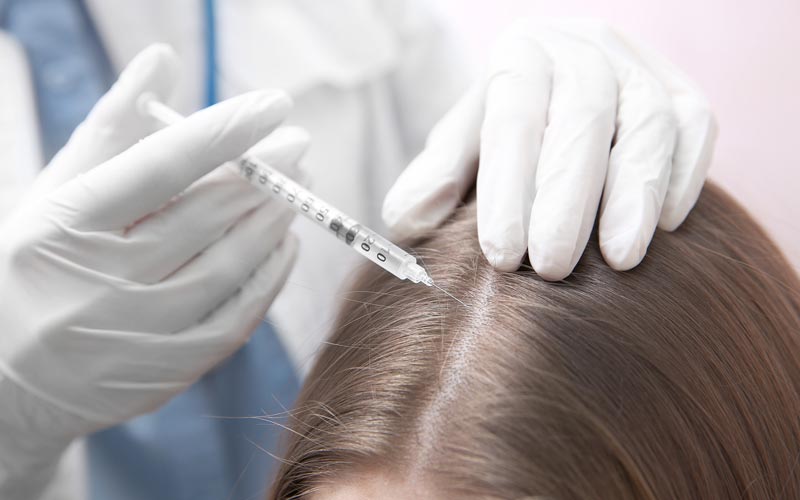Boomer Elmsdale

PRP, or platelet-rich plasma, injections have many purposes. They are often compared to stem cell injections wherein a part of the body is removed and then re-injected into another area to aid in healing. The difference is that PRP is taken by removing blood from a person—usually from the arm—and running it through a centrifuge machine before re-injecting it back into the body.
This method creates blood with a higher platelet concentration, which makes it ideal for promoting factors and healing damaged tissues, such as ligaments, tendons, joints and muscles. It can also help heal some musculoskeletal problems.
In some cases, ultrasound imaging is used to make sure the injection is placed properly, especially when the area of abnormal tissue being targeted is small. There have been several studies that have pointed to the success of this treatment for several ailments, including elbow, wrist, shoulder, hip, knee, and ankle tendonosis. It may also help heal osteoarthritis, although more research is needed to confirm PRP as a treatment.
It’s the clotting ability of platelets—a hybrid of cells and molecules—that makes them effective in healing, which is why there is no other treatment quite like it. Platelets are known for actively repairing and regenerating tissues, so pumping the problem area with over-concentrated blood makes biological sense, however it is complicated.
Because the procedure has become so popular in recent years, more research has been ordered and hopefully that means concrete answers regarding the effectiveness of the treatment are just around the corner. For now, a lot of the results surrounding PRP injections is anecdotal. The good news is, because the procedure utilizes the patients own blood, risks including allergic reaction are low and for many that means the risk-reward is skewed heavily in the favor of the reward.
The injections ordered must be placed precisely into the joint capsule for desired results. Because precision is such an important part of the procedure, a experienced physician should always be doing the injections. If the space is tricky to reach or particularly small, imaging technology can be used to aid the doctor in getting direct placement of the needle into the intended area.
The procedure typically takes 45-90 minutes from start to finish, which allows for the blood to be drawn, treated and then reinserted. In some cases, multiple injections may be the plan and in this case a doctor will often take one draw at the first appointment and use the same blood every time a new injection is scheduled. Other doctors prefer to use fresh blood every time and therefore the patient will be subject to a blood draw each time they get an injection.
To prepare for the procedure, talk with your doctor about appropriate protocols. Patients getting PRP injections should avoid corticosteroid medication in the weeks proceeding the procedure. NSAIDs should also be stopped about a week beforehand and anticoagulation medication five days before. Other preparation includes staying hydrated prior to the appointment and taking anti-anxiety medication if needed immediately before the procedure.
Those who get PRP injections do so to treat muscle, joint, tendon and ligament pain and tears as well as other musculoskeletal injuries. In some cases it is used to treat arthritis or overuse conditions in these areas of the body. It is commonly used for patellofemoral pain, a type of knee pain experienced by runners. Many athletes use the treatment to repair injuries without downtime.
Aside from athletes, those who have suffered a musculoskeletal injury or patients who suffer from arthritis also might check with their doctor about the possibility of having PRP injections. Other people use PRP injections to stimulate hair growth.
PRP injections are given to heal injured muscles, ligaments, tendons and joints. They can also relieve pain and symptoms associated with tendonitis, arthritis and other musculoskeletal issues. Many who opt to have PRP injections are athletes who have suffered injury, sometimes from overuse. In all cases, the goal is to heal and regenerate the affected part of the body, leading to complete recovery without surgery, medication or other interventions.
PRP injections are considered safe mostly because nothing foreign is being introduced into the body. With injections of other substances such as steroids or pain medications, risk of allergic reaction and other symptoms are possible. The biggest risk of PRP injections is the unknown. As of now, the procedure is newer and not heavily-backed by science. Research is being done to bring light to the all-natural procedure as a treatment for musculoskeletal pain, but some studies have failed to find a connection between the treatment and any healing.
The injection itself can cause infection, nerve damage, tissue damage and pain at the injection site.
If it works, PRP injections heal torn or damaged muscles, tendons, ligaments and joints reducing or eliminating pain associated with injury to these parts of the body as well as with arthritis.
The most common alternative to PRP injections are stem cell injections. These two procedures work similarly. In both cases, something is removed from the body and re-inserted into a small area with the hopes of healing something that is damaged or abnormal.
Aside from stem cell injections, some patients choose to use pain medication, enroll in physical therapy or undergo surgery to correct problems in these areas depending on the severity of the issue.
The cost of PRP injections varies greatly because the treatment has so many applications. It is pretty normal to see costs of $500-$2000 per treatment. Insurance, in some cases, may cover part or all of the associated cost.
“Platelet-Rich Plasma (PRP) Injections.” Hospital for Special Surgery. Accessed April 26, 2018. https://www.hss.edu/condition-list_prp-injections.asp.
Wilson, John J. “Platelet-Rich Plasma Injection Procedure.” Arthritis-health. Accessed April 26, 2018. https://www.arthritis-health.com/treatment/injections/platelet-rich-plasma-injection-procedure.
CCRN, Rachel Nall RN BSN. “Platelet-rich Plasma Therapy (PRP): Costs, Side Effects, and Treatments.” Medical News Today. Accessed April 26, 2018. https://www.medicalnewstoday.com/articles/320107.php.